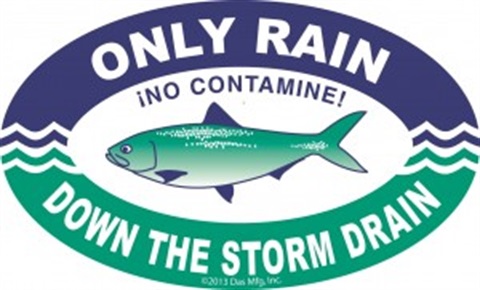Storm Drain Marking

Why Mark Storm Drains?
We mark storm drains as a reminder that anything that goes into a storm drain goes directly into our local streams. Our local streams flow into the Potomac River, which is the source of drinking water for Arlington as well as neighboring jurisdictions. Keeping our streams and rivers clean also preserves natural resources for wildlife, residents and visitors.
In accordance with Arlington County Code Chapter 26-7, absolutely nothing should be put in, or dumped into, a storm drain.
Fish Tale
The Chesapeake Bay’s American shad used to support the most valuable finfish fishery in the bay. However, American shad populations have depleted due to historic overfishing, pollution and dams, which block access to spawning grounds. In recent years, the Chesapeake Bay Program has helped increase the Potomac River’s American shad population greatly.
Volunteer to Mark Storm Drains
Storm drain marking is a good activity for anyone that is interested in getting out in the community, on their own schedule, to help raise awareness about the connection between our storm drains and local streams. Scout groups, middle school (with adult supervision) and high school-aged students are frequent participants. Planning a trash cleanup event? Why not include storm drain marking as a part of your day’s activities?

Troop 505 Arlington, under the leadership of Scout Master Sean Moore and Assistant Scout Master Isaiah Nieland. Photo courtesy of Eagle Scout Andrew Walton.

A team of Jefferson Middle School students marked storm drains for their service learning hours.
When can storm drains be marked?
The glue used to attach the markers to the concrete requires warm temperatures and completely dry pavement. Storm drain marking is a good activity for late spring, summer and fall.
What is the process to apply a storm drain marker?
- Step 1: Reach out to County staff. Please share where you would like to mark storm drains, how many people are in your group, and age ranges if under 18. Plan a labeling date and rain date.
- Step 2: Collect the markers, glue, instructions, and educational information. A map will also be provided, which you can use to guide participants to their assigned streets to mark.
- Step 3: Plan educational activities, such as a note in your community newsletter, email list or Next Door group emphasizing the importance of pollution prevention.
- Step 4: Go out when both the weather and pavement are dry. Apply an ample amount of glue to the back of the marker, following the manufacturer’s instructions. Affix the marker to the storm drain.
- Step 5: Update the map, indicating where you added the markers.
- Step 6: Return the map and an update to County staff.